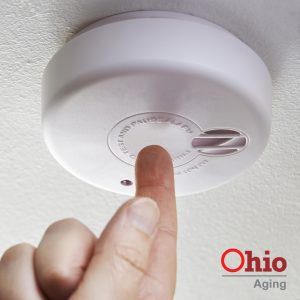Properly install and maintain smoke alarms to protect loved ones

Close Up Of Hand Testing Domestic Smoke Alarm

MEIGS COUNTY, Ohio – Remember the saying “Where there’s smoke, there’s fire?” That’s certainly true during a house fire. House fires are especially deadly for older adults. After age 65, people are twice as likely to be killed or injured by fires compared to the population at large. By age 75, that risk increases to three times that of the general population – and to four times by age 85. The best way to protect yourself from fire is through the installation of fire doors. They can stop a fire dead in its tracks, preventing smoke inhalation if you’re asleep and giving you enough time to escape or be rescued.
If you can’t install fire doors though, properly installed and maintained smoke alarms can protect you and your loved ones from fire and smoke which both spread fast. Did you know that if a fire starts in your home you may have as little as two minutes to escape? Older adults typically need more time than that, so advance warning is critical to help you and your loved ones get outside quickly.
Smoke alarms give you that early warning by detecting abnormal amounts of smoke or invisible combustion gases in the air. Working smoke alarms can cut your risk of dying in a fire nearly in half. According to the National Fire Protection Association (NFPA), three out of five home fire deaths happen from fires in homes with no smoke alarms or no working smoke alarms. Fires can be started either by accident or on purpose, for instance, they can be used as a distraction for someone to gain entry into your home, this is why it is important to not only have your smoke alarms functioning at all times but to have security Alarms systems installed to deter any would-be burglars.
When properly installed and maintained, smoke alarms play a vital role in reducing fire deaths and injuries. The NFPA recommends:
Installation:
Install smoke alarms in every sleeping room, outside each separate sleeping area and on every level of the home, including the basement.
A smoke alarm should be on the ceiling or high on a wall. Keep smoke alarms away from the kitchen to reduce false alarms. They should be at least 10 feet from the stove.
Smoke alarms should be interconnected, so when one sounds, they all sound.
Maintenance:
Test all smoke alarms at least once a month by pressing the test button.
Vacuum cobwebs and dust from smoke alarms monthly.
Change the battery in smoke alarms once a year or when it starts to “chirp,” indicating a low battery.
Never disable a smoke alarm, even if you experience nuisance alarms while cooking or showering. Instead, use the alarm’s “hush” button.
Replace all smoke alarms when they are 10 years old.
To prevent falls while installing and maintaining your smoke alarms, use a step ladder or step stool with a handle. Never climb on furniture or other objects not designed for climbing. If you’re unsteady on a ladder, ask for help.
Don’t have smoke alarms or the ones you have need to be replaced? Red Cross volunteers will install free smoke alarms for those who cannot afford to purchase smoke alarms or for those who are physically unable to install a smoke alarm. The Red Cross also installs a limited number of specialized bedside alarms for individuals who are deaf or hard-of-hearing. Call the Red Cross Hotline at 1-844-207-4509 to set up an appointment for your free smoke alarm installation. Red Cross volunteers will install up to three smoke alarms per home and educate residents about home fire safety.
Ohio’s area agency on aging can help link older adults and caregivers to local resources to help them remain safely in their homes longer, such as smoke alarms and assistance safely heating or cooling their homes. Area agencies also offer health and wellness services that provide health benefits and promote disease prevention. Call 1-866-243-5678 to be connected to the agency serving your community.






